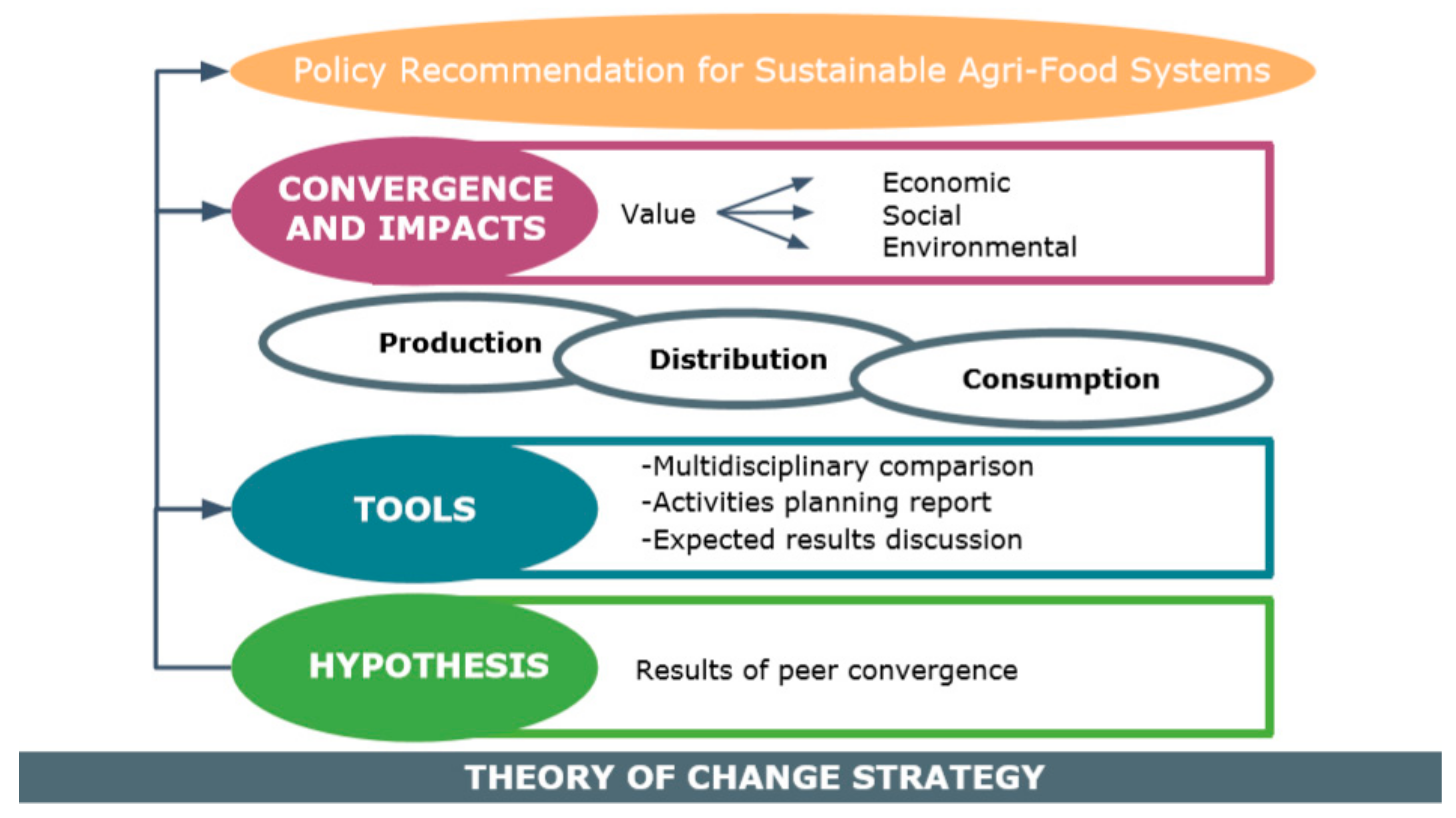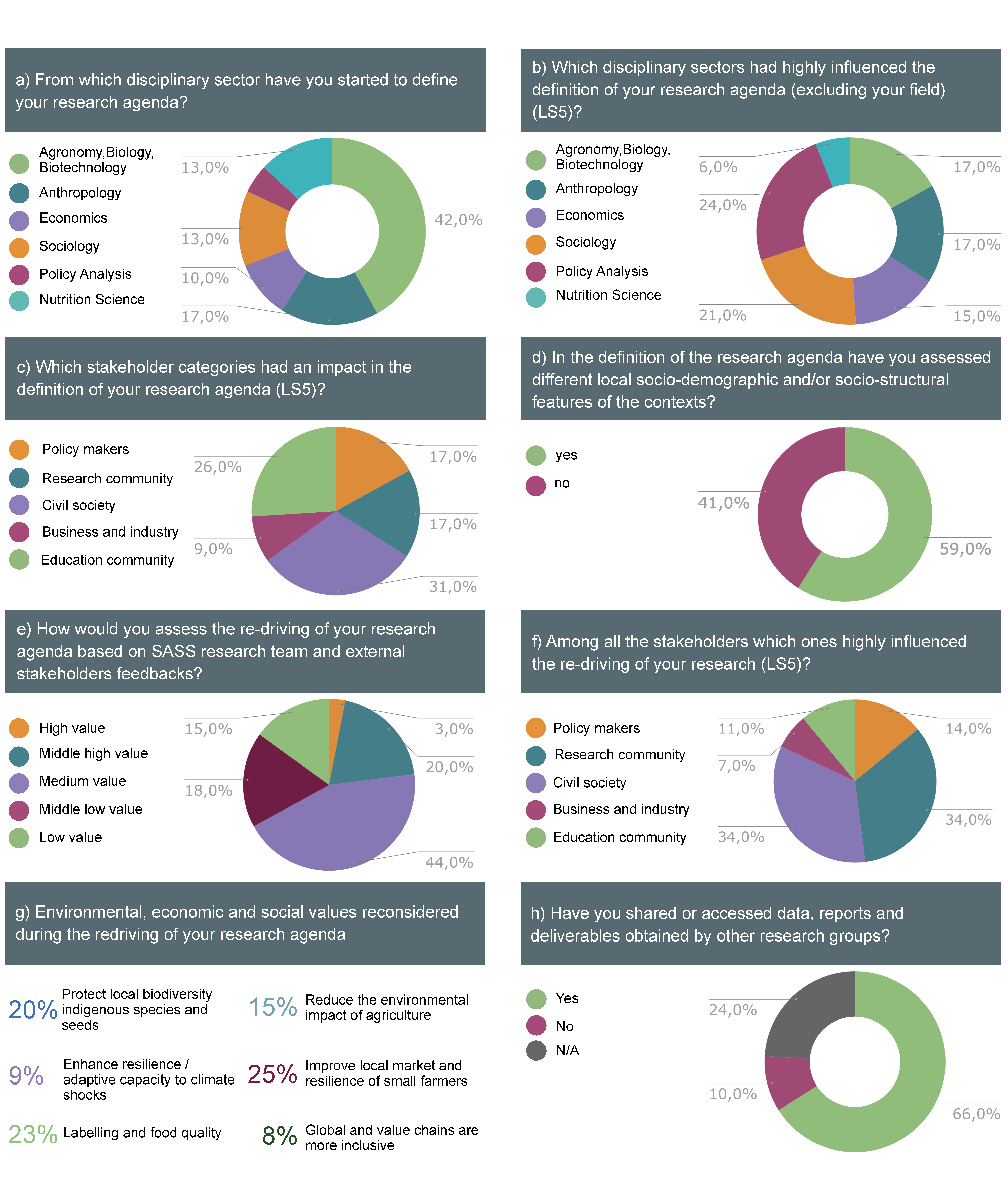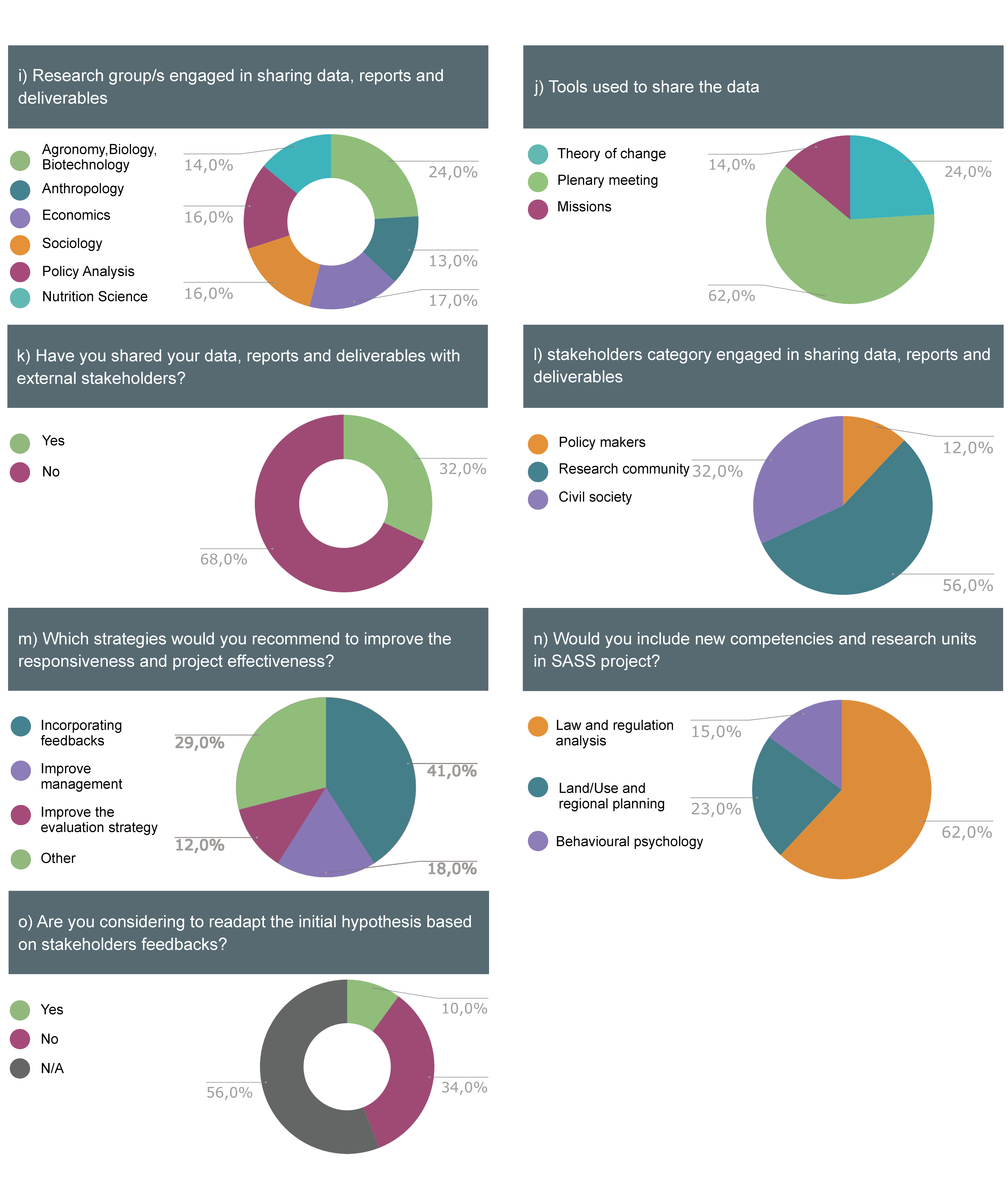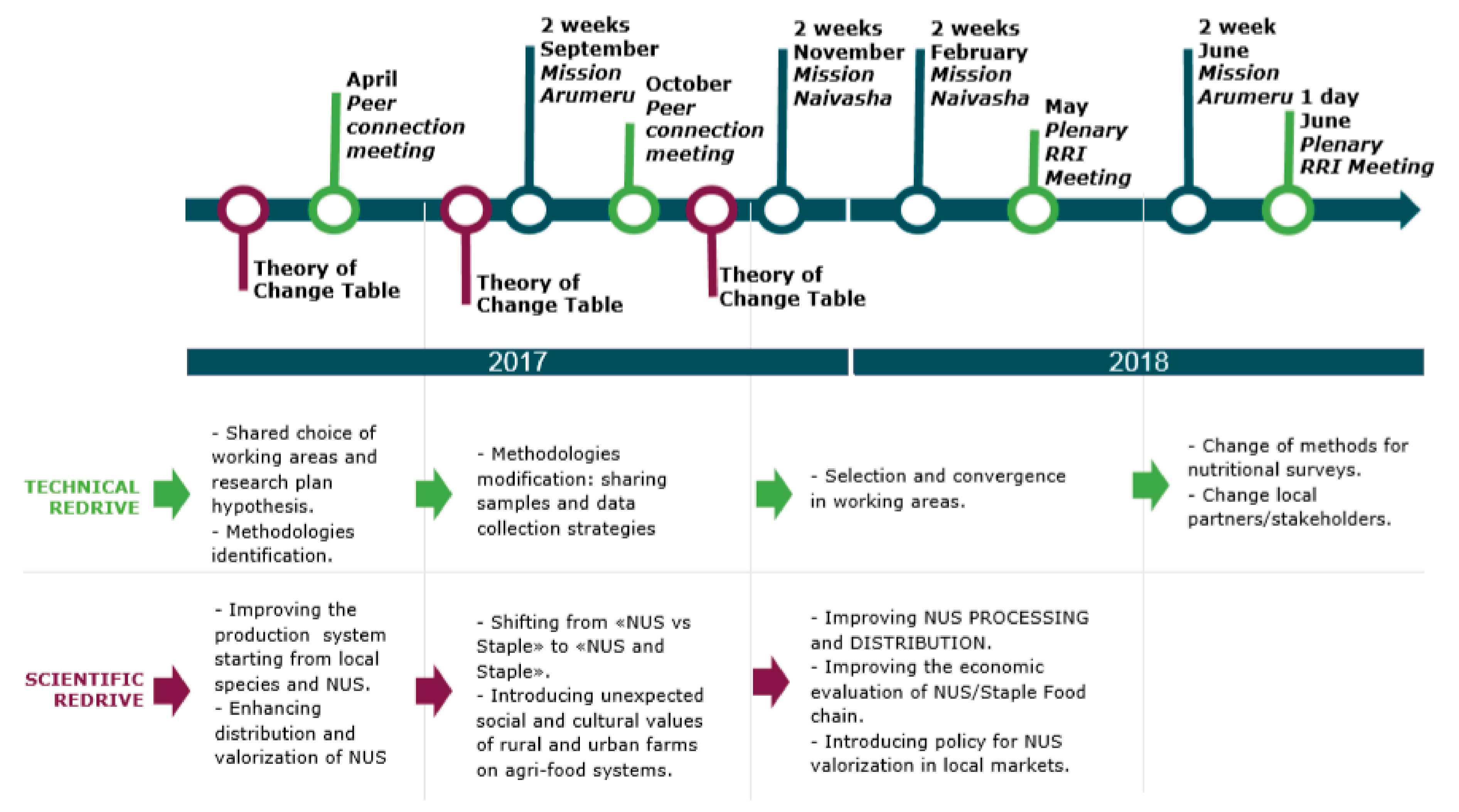Experimenting with RRI tools to Drive Sustainable Agri-Food Research: The SASS Case Study from Sub-Saharan Africa
Abstract
1. Introduction
- (1)
- The research on agri-food systems is usually multidisciplinary, with many perspectives for innovation. The definition of problems in agricultural supply chains has often been analyzed in depth only by one or a few disciplines, causing problems when spreading technological and organizational progress. For example, the genetic improvement of crops was mainly promoted by agronomists and biologists, but these disciplines rarely took into consideration social, ethical and economic aspects. There are several examples of successful GMO crops at the biological level that do not reach the market due to economic, cultural, or legal critiques [16,17,18]. The RRI approach could help address these critical issues by sharing strategies and responsibilities with stakeholders and transforming scientific results into agronomic innovations for farmers [6,19], evidence for public policy making, and financial strategies for the banking industry.
- (2)
- The project SASS involves researchers belonging to several disciplines such as biology, agronomy, nutritional science, sociology, anthropology, economics, and policy making. To date, very few tools have been proposed and tested to support RRI assessment in such a large and diverse research consortia (e.g., [20]). Although the adoption of multidisciplinary research strategies has largely been encouraged in those public EU research programs dealing with food (i.e., [21]), only a few projects related to the "food and health” topic were developed under a multidisciplinary view, as suggested in the EU-FAHRE program [22]. Moreover, several scholars have noticed how the adoption of measures to promote open innovation processes between multidisciplinary agri-food research consortia and the engagement of SMEs, civil society organizations, and local community groups is still fragmented (i.e., [23,24,25,26,27]).
- (3)
- The project SASS represents the opportunity to recognize and explore the practical dimension of RRI in agri-food research in those contexts characterized by a strong separation between technological innovation and political power imbalances, cultural asymmetries, the management of environmental resource exploitation, and socio-economic inequalities [28]. Sub-Saharan Africa is a particularly risky context, where the adoption of agricultural technologies underwent a complex process influenced by both extrinsic and intrinsic cultural variables [29,30]. A mechanistic understanding of these factors and their interactions through an RRI strategy could represent a valuable approach to reassess and converge the research outcomes towards the adoption of new technologies and production organization (e.g., the adoption of intercropping), helping to target policies suitable for ensuring sustainability [31]. Moreover, it is important to underline that the results and policy outcomes of SASS would be transferred in order to ameliorate non-resilient agricultural systems that are suffering from the erosion of the local environmental resources (e.g., [32]) and increasing social vulnerability (e.g., [33]). Therefore, it is essential that the critical issues highlighted by all the stakeholders are taken into account and that only the best shared and sustainable strategies will be translated into practical actions.
2. Background: Responsible Research and Innovation
3. Testing the New Proposed Frameworks of ‘Internal RRI’ and ‘External RRI’
4. Methodology
4.1. Framing the “SASS” Research Agenda
4.2. SASS Research Team
4.3. RRI Tools
4.4. Survey
4.4.1. Diversity and Inclusiveness
4.4.2. Anticipation and Reflection
4.4.3. Openness and Transparency
4.4.4. Responsiveness and Adaptation to Change
5. Results
5.1. The Effect of the Internal RRI Analysis on Research Project Development
5.2. Sharing Responsibilities through Internal RRI Strategies
6. Discussion
6.1. The Efficacy of RRI Tools to Improve the SASS Project
6.2. Analytical Evaluation of the Internal RRI Process
6.3. Policy Implications and Conclusions
Author Contributions
Funding
Acknowledgments
Conflicts of Interest
Appendix A


References
- Dosi, G. Technological paradigms and technological trajectories: A suggested interpretation of the determinants and directions of technical change. Res. Policy 1982, 11, 147–162. [Google Scholar] [CrossRef]
- George, G.; McGahan, A.M.; Prabhu, J. Innovation for inclusive growth: Towards a theoretical framework and a research agenda. J. Manag. Stud. 2012, 49, 661–683. [Google Scholar] [CrossRef]
- Rodríguez-Pose, A. The revenge of the places that don’t matter (and what to do about it). Camb. J. Reg. Econ. Soc. 2018, 11, 189–209. [Google Scholar] [CrossRef]
- Phelan, J.C.; Link, B.G.; Tehranifar, P. Social Conditions as Fundamental Causes of Health Inequalities: Theory, Evidence, and Policy Implications. J. Health Soc. Behav. 2010, 51, S28–S40. [Google Scholar] [CrossRef] [PubMed]
- Whitehead, M.; Pennington, A.; Orton, L.; Nayak, S.; Petticrew, M.; Sowden, A.; White, M. How could differences in ‘control over destiny’lead to socio-economic inequalities in health? A synthesis of theories and pathways in the living environment. Health Place 2016, 39, 51–61. [Google Scholar] [CrossRef] [PubMed]
- Martinuzzi, A.; Blok, V.; Brem, A.; Stahl, B.; Schönherr, N. Responsible Research and Innovation in Industry—Challenges, Insights and Perspectives; Multidisciplinary Digital Publishing Institute: Basel, Switzerland, 2018. [Google Scholar]
- Simone, A. Steering research and innovation through RRI. What horizon for Europe? J. Sci. Commun. 2018, 17, C02. [Google Scholar] [CrossRef]
- Commission, E. Horizon 2020. The EU Framework Programme for Research and Innovation. Available online: https://ec.europa.eu/programmes/horizon2020/ (accessed on 8 January 2020).
- Forsberg, E.-M.; Shelley-Egan, C.; Ladikas, M.; Owen, R. Implementing Responsible Research and Innovation in Research Funding and Research Conducting Organisations—What Have We Learned so Far? In Governance and Sustainability of Responsible Research and Innovation Processes; Springer: New York, NY, USA, 2018; pp. 3–11. [Google Scholar]
- RRI-Practice Project website. Available online: www.rri-practice.eu (accessed on 8 January 2020).
- Graeub, B.E.; Chappell, M.J.; Wittman, H.; Ledermann, S.; Kerr, R.B.; Gemmill-Herren, B. The state of family farms in the world. World Dev. 2016, 87, 1–15. [Google Scholar] [CrossRef]
- Reincke, K.; Vilvert, E.; Fasse, A.; Graef, F.; Sieber, S.; Lana, M.A. Key factors influencing food security of smallholder farmers in Tanzania and the role of cassava as a strategic crop. Food Secur. 2018, 10, 911–924. [Google Scholar] [CrossRef]
- Wenban-Smith, H.; Fasse, A.; Grote, U. Food security in Tanzania: The challenge of rapid urbanisation. Food Secur. 2016, 8, 973–984. [Google Scholar] [CrossRef]
- AGRA. Africa Agriculture Status Report: The Business of Smallholder Agriculture in Sub-Saharan Africa; Alliance for a Green Revolution in Africa (AGRA): Nairobi, Kenya, 2017. [Google Scholar]
- Brüntrup, M.; Schwarz, F.; Absmayr, T.; Dylla, J.; Eckhard, F.; Remke, K.; Sternisko, K. Nucleus-outgrower schemes as an alternative to traditional smallholder agriculture in Tanzania—Strengths, weaknesses and policy requirements. Food Secur. 2018, 10, 807–826. [Google Scholar] [CrossRef]
- Lyndhurst, B. An Evidence Review of Public Attitudes to Emerging Food Technologies; Social Science Research Unit, Food Standards Agency: Crown, OH, USA, 2009; Available online: https://pdfs.semanticscholar.org/bc51/81ed6ca06cc7935c11eb14afeff6c892ffb4.pdf (accessed on 8 January 2020).
- Klerck, D.; Sweeney, J.C. The effect of knowledge types on consumer-perceived risk and adoption of genetically modified foods. Psychol. Mark. 2007, 24, 171–193. [Google Scholar] [CrossRef]
- Nicholas, P.; Mandolesi, S.; Naspetti, S.; Zanoli, R. Innovations in low input and organic dairy supply chains—What is acceptable in Europe? J. Dairy Sci. 2014, 97, 1157–1167. [Google Scholar] [CrossRef] [PubMed]
- Long, T.B.; Blok, V.; Coninx, I. Barriers to the adoption and diffusion of technological innovations for climate-smart agriculture in Europe: Evidence from the Netherlands, France, Switzerland and Italy. J. Clean. Prod. 2016, 112, 9–21. [Google Scholar] [CrossRef]
- RRI Tools Project. Available online: www.rri-tools.eu (accessed on 8 January 2020).
- Khan, S.S.; Timotijevic, L.; Newton, R.; Coutinho, D.; Llerena, J.L.; Ortega, S.; Benighaus, L.; Hofmaier, C.; Xhaferri, Z.; de Boer, A. The framing of innovation among European research funding actors: Assessing the potential for ‘responsible research and innovation’in the food and health domain. Food Policy 2016, 62, 78–87. [Google Scholar] [CrossRef]
- McCarthy, M.; Cluzel, E.; Dressel, K.; Newton, R. Food and health research in Europe: Structures, gaps and futures. Food Policy 2013, 39, 64–71. [Google Scholar] [CrossRef]
- Scoones, I.; Thompson, J. Farmer First Revisited: Innovation for Agricultural Research and Development; Technical Centre for Agricultural and Rural Cooperation: Wageningen, The Netherlands, 2009. [Google Scholar]
- Martinez, M.G. Open Innovation in the Food and Beverage Industry; Elsevier: Amsterdam, The Netherlands, 2013. [Google Scholar]
- Levidow, L.; Birch, K.; Papaioannou, T. Divergent paradigms of European agro-food innovation: The knowledge-based bio-economy (KBBE) as an R&D agenda. Sci. Technol. Hum. Values 2013, 38, 94–125. [Google Scholar]
- Geissler, J.-B.; Tricarico, L.; Vecchio, G. The construction of a trading zone as political strategy: A review of London Infrastructure Plan 2050. Eur. J. Spat. Dev. 2017, 54, 1–22. [Google Scholar]
- Tricarico, L.; Sganzetta, L.M.; Quaglia, S. Community entrepreneurship in sustainable food places. Community Entrep. Sustain. Food Places 2018, 87, 105–112. [Google Scholar] [CrossRef]
- Conceição, P.; Levine, S.; Lipton, M.; Warren-Rodríguez, A. Toward a food secure future: Ensuring food security for sustainable human development in Sub-Saharan Africa. Food Policy 2016, 60, 1–9. [Google Scholar] [CrossRef]
- Meijer, S.S.; Catacutan, D.; Ajayi, O.C.; Sileshi, G.W.; Nieuwenhuis, M. The role of knowledge, attitudes and perceptions in the uptake of agricultural and agroforestry innovations among smallholder farmers in sub-Saharan Africa. Int. J. Agric. Sustain. 2015, 13, 40–54. [Google Scholar] [CrossRef]
- Burian, A.; Karaya, R.; Wernersson, J.E.; Egberth, M.; Lokorwa, B.; Nyberg, G. A community-based evaluation of population growth and agro-pastoralist resilience in Sub-Saharan drylands. Environ. Sci. Policy 2019, 92, 323–330. [Google Scholar] [CrossRef]
- Khan, Z.R.; Midega, C.A.; Pittchar, J.O.; Murage, A.W.; Birkett, M.A.; Bruce, T.J.; Pickett, J.A. Achieving food security for one million sub-Saharan African poor through push-pull innovation by 2020. Philos. Trans. R. Soc. B Biol. Sci. 2014, 369, 20120284. [Google Scholar] [CrossRef]
- Dile, Y.T.; Karlberg, L.; Temesgen, M.; Rockström, J. The role of water harvesting to achieve sustainable agricultural intensification and resilience against water related shocks in sub-Saharan Africa. Agric. Ecosyst. Environ. 2013, 181, 69–79. [Google Scholar] [CrossRef]
- Chuku, C.A.; Okoye, C. Increasing resilience and reducing vulnerability in sub-Saharan African agriculture: Strategies for risk coping and management. Afr. J. Agric. Res. 2009, 4, 1524–1535. [Google Scholar]
- Owen, R.; Macnaghten, P.; Stilgoe, J. Responsible research and innovation: From science in society to science for society, with society. Sci. Public Policy 2012, 39, 751–760. [Google Scholar] [CrossRef]
- Gurzawska, A.; Mäkinen, M.; Brey, P. Implementation of Responsible Research and Innovation (RRI) practices in industry: Providing the right incentives. Sustainability 2017, 9, 1759. [Google Scholar] [CrossRef]
- Van de Poel, I.; Asveld, L.; Flipse, S.; Klaassen, P.; Scholten, V.; Yaghmaei, E. Company strategies for responsible research and innovation (RRI): A conceptual model. Sustainability 2017, 9, 2045. [Google Scholar] [CrossRef]
- Responsible Research and Innovation in Business and Industry in the Domain of ICT for, Health, Demographic Change and Wellbeing. Available online: http://www.responsible-industry.eu/ (accessed on 8 January 2020).
- Jasanoff, S. Designs on Nature: Science and Democracy in Europe and the United States; Princeton University Press: Princeton, NJ, USA, 2011. [Google Scholar]
- Ligardo-Herrera, I.; Gómez-Navarro, T.; Inigo, E.; Blok, V. Addressing climate change in responsible research and innovation: Recommendations for its operationalization. Sustainability 2018, 10, 2012. [Google Scholar] [CrossRef]
- Wilsdon, J.; Willis, R. See-through Science: Why Public Engagement Needs to Move Upstream; Demos: New York, NY, USA, 2004. [Google Scholar]
- Stilgoe, J.; Owen, R.; Macnaghten, P. Developing a framework for responsible innovation. Res. Policy 2013, 42, 1568–1580. [Google Scholar] [CrossRef]
- Von Schomberg, R. A vision of responsible research and innovation. Responsible Innov. Manag. Responsible Emerg. Sci. Innov. Soc. 2013, 51–74. [Google Scholar] [CrossRef]
- Long, T.B.; Blok, V.; Dorrestijn, S.; Macnaghten, P. The design and testing of a tool for developing responsible innovation in start-up enterprises. J. Responsible Innov. 2019, 1–31. [Google Scholar] [CrossRef]
- Calliera, M.; L’Astorina, A. The Role of Research, Communication, and Education for a Sustainable Use of Pesticides. In Advances in Chemical Pollution, Environmental Management and Protection; Elsevier: Amsterdam, The Netherlands, 2018; Volume 2, pp. 109–132. [Google Scholar]
- L’Astorina, A.; Di Fiore, M. A New Bet for Scientists: Implementing the Responsible Research and Innovation (RRI) Approach in the Research Practices. Rel. Beyond Anthr. 2017, 5, 157. [Google Scholar] [CrossRef]
- NUCLEUS Project. Available online: www.nucleus-project.eu (accessed on 8 January 2020).
- Brandt, P.; Ernst, A.; Gralla, F.; Luederitz, C.; Lang, D.J.; Newig, J.; Reinert, F.; Abson, D.J.; Von Wehrden, H. A review of transdisciplinary research in sustainability science. Ecol. Econ. 2013, 92, 1–15. [Google Scholar] [CrossRef]
- Gorman, M.E. Levels of expertise and trading zones: A framework for multidisciplinary collaboration. Soc. Stud. Sci. 2002, 32, 933–938. [Google Scholar] [CrossRef]
- Mäntysalo, R.; Balducci, A.; Kangasoja, J. Planning as agonistic communication in a trading zone: Re-examining Lindblom’s partisan mutual adjustment. Plan. Theory 2011, 10, 257–272. [Google Scholar] [CrossRef]
- Jayne, T.; Muyanga, M.; Wineman, A.; Ghebru, H.; Stevens, C.; Stickler, M.; Chapoto, A.; Anseeuw, W.; van der Westhuizen, D.; Nyange, D. Are medium-scale farms driving agricultural transformation in sub-Saharan Africa? Agric. Econ. 2019, 50, 75–95. [Google Scholar] [CrossRef]
- Snyder, K.A.; Sulle, E.; Massay, D.A.; Petro, A.; Qamara, P.; Brockington, D. “Modern” farming and the transformation of livelihoods in rural Tanzania. Agric. Hum. Values 2019, 1–14. [Google Scholar] [CrossRef]
- Assefa, T.; Jha, M.; Reyes, M.; Worqlul, A. Modeling the Impacts of Conservation Agriculture with a Drip Irrigation System on the Hydrology and Water Management in Sub-Saharan Africa. Sustainability 2018, 10, 4763. [Google Scholar] [CrossRef]
- Campanaro, A.; Tommasi, N.; Guzzetti, L.; Galimberti, A.; Bruni, I.; Labra, M. DNA barcoding to promote social awareness and identity of neglected, underutilized plant species having valuable nutritional properties. Food Res. Int. 2019, 115, 1–9. [Google Scholar] [CrossRef] [PubMed]
- Kiwia, A.; Kimani, D.; Harawa, R.; Jama, B.; Sileshi, G.W. Sustainable Intensification with Cereal-Legume Intercropping in Eastern and Southern Africa. Sustainability 2019, 11, 2891. [Google Scholar] [CrossRef]
- Oikos. S.A.F.E. Gardens Project Summary. Available online: http://oikosea.org/projects/s-a-f-e-gardens/ (accessed on 8 January 2020).
- Roberts, M.; Melecky, M.; Bougna, T.; Xu, Y. Transport Corridors and Their Wider Economic Benefits: A Critical Review of the Literature; The World Bank: Washington, DC, USA, 2018. [Google Scholar]
- Herrmann, R.; Nkonya, E.; Faße, A. Food value chain linkages and household food security in Tanzania. Food Secur. 2018, 10, 827–839. [Google Scholar] [CrossRef]
- Abrahams, Z.; Mchiza, Z.; Steyn, N.P. Diet and mortality rates in Sub-Saharan Africa: Stages in the nutrition transition. BMC Public Health 2011, 11, 801. [Google Scholar] [CrossRef]
- Conti, M.V.; Campanaro, A.; Coccetti, P.; De Giuseppe, R.; Galimberti, A.; Labra, M.; Cena, H. Potential role of neglected and underutilized plant species in improving women’s empowerment and nutrition in areas of sub-Saharan Africa. Nutr. Rev. 2019, 77, 817–828. [Google Scholar] [CrossRef] [PubMed]
- Van Kleef, E.; Van Trijp, J.; Van Den Borne, J.; Zondervan, C. Successful development of satiety enhancing food products: Towards a multidisciplinary agenda of research challenges. Crit. Rev. Food Sci. Nutr. 2012, 52, 611–628. [Google Scholar] [CrossRef]
- Taplin, D.H.; Clark, H. Theory of Change Basics: A Primer on Theory of Change; New York Actknowledge: New York, NY, USA, 2012. [Google Scholar]
- Bhaskar, R.; Danermark, B.; Price, L. Interdisciplinarity and Wellbeing: A Critical Realist General Theory of Interdisciplinarity; Routledge: Abingdon, UK, 2017. [Google Scholar]
- Griffiths, M. Educational Research for Social Justice: Getting off the Fence; McGraw-Hill Education (UK): London, UK, 1998. [Google Scholar]
- Nind, M. What is Inclusive Research? A&C Black: London, UK, 2014. [Google Scholar]
- Norman, D.A.; Verganti, R. Incremental and radical innovation: Design research vs. technology and meaning change. Des. Issues 2014, 30, 78–96. [Google Scholar] [CrossRef]
- Egeland, C.; Forsberg, E.-M.; Maximova-Mentzoni, T. RRI: Implementation as learning. J. Responsible Innov. 2019, 1–6. [Google Scholar] [CrossRef]
- Buchan, R.; Cloutier, D.S.; Friedman, A. Transformative incrementalism: Planning for transformative change in local food systems. Prog. Plan. 2019, 134, 100424. [Google Scholar] [CrossRef]
- Schön, D.A. The crisis of professional knowledge and the pursuit of an epistemology of practice. J. Interprof. Care 1992, 6, 49–63. [Google Scholar] [CrossRef]
- Bronson, K. Smart farming: Including rights holders for responsible agricultural innovation. Technol. Innov. Manag. Rev. 2018, 8, 7–14. [Google Scholar] [CrossRef]
- Eastwood, C.; Klerkx, L.; Ayre, M.; Rue, B.D. Managing socio-ethical challenges in the development of smart farming: From a fragmented to a comprehensive approach for responsible research and innovation. J. Agric. Environ. Ethics 2019, 32, 741–768. [Google Scholar] [CrossRef]
- Rose, D.; Chilvers, J. Agriculture 4.0: Responsible innovation in an era of smart farming. Front. Sustain. Food Syst. 2018, 2, 87. [Google Scholar] [CrossRef]
- Steiner, A. The extraordinary opportunity of the 2030 Agenda for Sustainable Development. Eur. J. Dev. Res. 2018, 30, 163–165. [Google Scholar] [CrossRef]
- PRIMA—Partnership for Research and Innovation in the Mediterranean Area. Available online: http://prima-med.org/ (accessed on 8 January 2020).





| Sustainable Agri-Food Systems for Sustainable Development Team Composition | ||
|---|---|---|
| Discipline | Affiliation | Number of Researchers |
| Biology | University of Milano-Bicocca (Milan, Italy) University of Gastronomic Science (Pollenzo, Italy) | 23 |
| Agronomy | Catholic University (Piacenza, Italy) | 7 |
| Nutrition | University of Pavia (Pavia, Italy) | 4 |
| Sociology | University of Milano-Bicocca (Milan, Italy) | 3 |
| Anthropology | University of Milano-Bicocca (Milan, Italy) University of Gastronomic Sciences (Pollenzo, Italy) | 8 |
| Economics | University of Pavia (Pavia, Italy) University of Gastronomic Science (Pollenzo, Italy) | 6 |
| Policy | European Center for Development Policy Management, Maastricht, the Netherlands (Maastricht, the Netherlands) | 6 |
© 2020 by the authors. Licensee MDPI, Basel, Switzerland. This article is an open access article distributed under the terms and conditions of the Creative Commons Attribution (CC BY) license (http://creativecommons.org/licenses/by/4.0/).
Share and Cite
Tricarico, L.; Galimberti, A.; Campanaro, A.; Magoni, C.; Labra, M. Experimenting with RRI tools to Drive Sustainable Agri-Food Research: The SASS Case Study from Sub-Saharan Africa. Sustainability 2020, 12, 827. https://doi.org/10.3390/su12030827
Tricarico L, Galimberti A, Campanaro A, Magoni C, Labra M. Experimenting with RRI tools to Drive Sustainable Agri-Food Research: The SASS Case Study from Sub-Saharan Africa. Sustainability. 2020; 12(3):827. https://doi.org/10.3390/su12030827
Chicago/Turabian StyleTricarico, Luca, Andrea Galimberti, Ausilia Campanaro, Chiara Magoni, and Massimo Labra. 2020. "Experimenting with RRI tools to Drive Sustainable Agri-Food Research: The SASS Case Study from Sub-Saharan Africa" Sustainability 12, no. 3: 827. https://doi.org/10.3390/su12030827
APA StyleTricarico, L., Galimberti, A., Campanaro, A., Magoni, C., & Labra, M. (2020). Experimenting with RRI tools to Drive Sustainable Agri-Food Research: The SASS Case Study from Sub-Saharan Africa. Sustainability, 12(3), 827. https://doi.org/10.3390/su12030827







